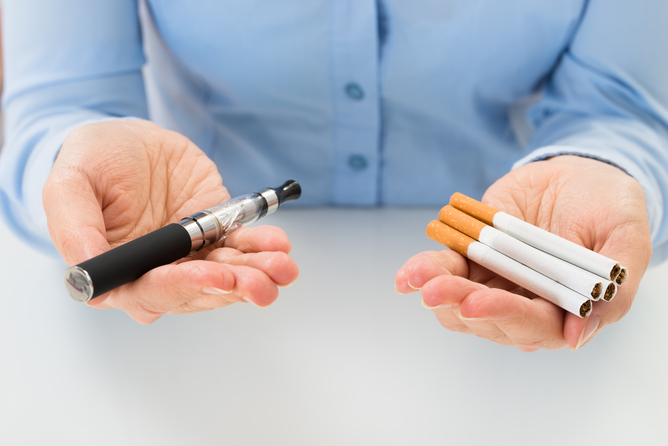What’s really in your e-cigarettes? The main ingredients in e-cigs or vapes are nicotine, either propylene glycol or vegetable glycerine and other added flavors depending on the variety. These ingredients get heated into vapors and inhaled. So, is this safe?
The truth is, we don’t know. And that should scare you.
There are no FDA regulations whatsoever on e-cigs or vapes. The companies that make the wide variety of liquid flavors are not forced to do any testing or to prove any level of safety before selling their products to the masses. Sadly, our youth, who are increasingly embracing this new “smoking alternative”, are going to be the guinea pigs for e-cigarettes’ safety- or lack thereof.
There have been countless independent studies, many done by well-accredited colleges, that have tested these liquids for chemical contaminants. Two of the biggest offenders that they look for are diacetyl and 2,3-pentanedione (acetyl propionyl). While so many of the hundreds of different flavored liquids claim to be free of these two ingredients, testing has proven otherwise. Since there are no laws enforcing safety, companies are not willing to go out of their way to pay the big bucks to do high-end testing looking for these ingredients. They either just take the word of their manufacturer or do some cheap, low-end testing and rush their product to market.
What are Diacetyl and 2,3 Pentanedione?
Diacetyl and 2,3 pentanedione are both known for giving foods their buttery flavor. They can be found in things like chips and candies. While these ingredients have been deemed safe to consume in trace amounts, they have been shown to be dangerous when inhaled.
Diacetyl is a well known ingredient in microwavable popcorn. Proving the dangers of inhaling this substance, the workers in microwave popcorn factories have been found to develop what they call “popcorn lung“. Their long term exposure to diacetyl causes irreversible damage to the lungs and even death.
Are These Dangerous Chemicals in Your E-Cigarettes?
Whether the label says it or not, chances are it may be. As I mentioned, companies are not doing the appropriate testing and the FDA is not requiring it be done. Some companies choose not to test their liquids for these chemicals at all, while others use the cheapest testing methods out there. Proper testing by outside sources has proven time and time again companies claiming to be free of these lung-destroying ingredients are in fact not.
A recent Harvard study found that diacetyl was found in 75% of the e-cigarette liquids they tested.
Other Dangerous Chemicals Found in E-Cigs
Multiple studies have found acetaldehyde, formaldehyde and toxic metals such as cadmium, nickel and lead in the liquid vapors. While in smaller amounts than you’d be receiving in actual cigarettes, we can’t overlook the fact that they are still there and still being inhaled into your lungs.
One of the main ingredients in e-cigs and vapes is propylene glycol. This has been touted as safe because the FDA has labeled it as GRAS (generally recognized as safe). But this is misleading. Propylene glycol has been deemed generally safe as a food additive and a cosmetics ingredient. We do not know how safe it is when heated and inhaled through vapor. The research simply isn’t there.
Are E-Cigs Better Than Smoking?
 Most e-cig and vape companies market their product as a short term use device to help you quit smoking. If that were the case, this could be considered a good choice over smoking. You would use it for a short term to stop smoking and then stop the e-cigs. But that is not what is happening. People are simply replacing cigarettes with e-cigs and vapes and using them for the long haul. While you aren’t exposing your lung to the slue of carcinogens and chemicals in cigarettes, you are now exposing your lungs to a new array of dangerous substances.
Most e-cig and vape companies market their product as a short term use device to help you quit smoking. If that were the case, this could be considered a good choice over smoking. You would use it for a short term to stop smoking and then stop the e-cigs. But that is not what is happening. People are simply replacing cigarettes with e-cigs and vapes and using them for the long haul. While you aren’t exposing your lung to the slue of carcinogens and chemicals in cigarettes, you are now exposing your lungs to a new array of dangerous substances.
The not so popular answer here is that neither are good for you. Neither are safe. You are inhaling dangerous, potentially toxic substances directly into your lungs.
The Takeaway
What it all comes down to is that these cigarette alternatives are something new. Their true impact on our health is not yet known. What is known is that the ingredients found in e-cigarettes are highly suspicious and some of them very dangerous. There is no science or data to prove them safe for inhalation and, I don’t know about you, but I don’t want to be the “test” generation to determine just how dangerous these ingredients really are.





1 Comment
That’s a smart way of thkiinng about it.